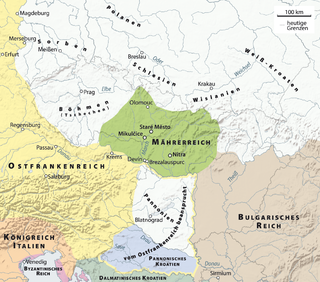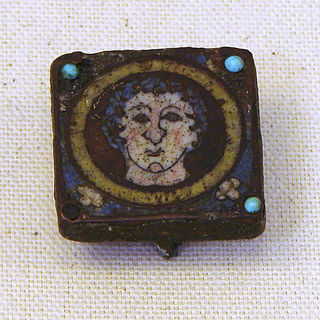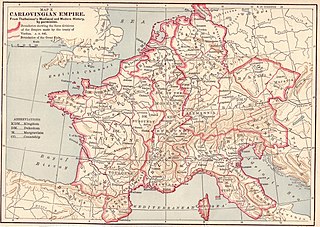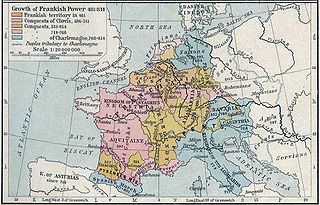Baldric or Balderic (Bald[e]ricus) was the Duke of Friuli (dux Foroiuliensis) from 819, when he replaced Cadolah according to Thegan of Trier in his Vita Hludowici imperatoris , until 828, when he was removed from office: the last Duke of Friuli.
Baldric was an imperial legate in 815, when he crossed into Zealand with an army of Saxons and Abotrites to restore the deposed King of Denmark, Harald Klak.
As ruler of Friuli, Baldric continued Cadolah's war against Ljudevit Posavski (Liudovitus), the Pannonian Croat leader. He was successful in expelling Ljudevit from imperial territory. He and Count Gerold also made war on the Bulgars at the order of Bertric, the count of the palace, in 826.
With George, presbyter of Venice, he escorted a hydraulic organ to Aachen in 826. [1]
In 828, Baldric was removed from Friuli for his failure to have mounted an effective defense against the Bulgars during their invasion of 827, and the dukedom was divided into four counties. [2] Eventually the counties would be united under a marchio (margrave), but the duchy would never be restored.

Zwentibold, a member of the Carolingian dynasty, was the illegitimate son of Emperor Arnulf. In 895, his father, then king of East Francia, granted him the Kingdom of Lotharingia, which he ruled until his death.
Bernardof Septimania (795–844), son of William of Gellone, was the Frankish Duke of Septimania and Count of Barcelona from 826 to 832 and again from 835 to his execution. He was also count of Carcassonne from 837. He was appointed to succeed his fellow Frank Rampon. During his career, he was one of the closest counsellors of the Emperor Louis the Pious, a leading proponent of the war against the Moors, and opponent of the interests of the local Visigothic nobility.
The Royal Frankish Annals are Latin annals composed in Carolingian Francia, recording year-by-year the state of the monarchy from 741 to 829. Their authorship is unknown, though Wilhelm von Giesebrecht suggested that Arno of Salzburg was the author of an early section of the Annales Laurissenses majores surviving in the copy at Lorsch Abbey. The Annals are believed to have been composed in successive sections by different authors, and then compiled.

Ljudevit or Liudewit, was the Duke of the Slavs in Lower Pannonia from 810 to 823. The capital of his realm was in Sisak. As the ruler of the Pannonian Slavs, he led a resistance to Frankish domination. Having lost the war against Franks, he fled to the south, presumably to Dalmatia, first to an unknown Serb župa, and then to the Croat ruler Ljudemisl, who treacherously killed him.

Borna was the Duke of Croatia from c. 810 to 821 and vassal of the Frankish Empire. He resided in Nin and was the ruler of most of the Croats in northern Dalmatia.

Ratimir was a duke or prince (knez) of the Slavs in Lower Pannonia between ca. 829 to 838. It is believed that Ratimir descends from a royal dynasty that provided rulers for Moravia and Croatia.

Thegan of Trier was a Frankish Roman Catholic prelate and the author of Gesta Hludowici imperatoris which is a principal source for the life of the Holy Roman Emperor Louis the Pious, the son and successor of Charlemagne.
Guerin, Garin, Warin, or Werner was the Count of Auvergne, Chalon, Mâcon, Autun, Arles and Duke of Provence, Burgundy, and Toulouse. Guerin established the region against the Saracens from a base of Marseille and fortified Chalon-sur-Saône (834). He took part in many campaigns during the civil wars that marked the reign of Louis the Pious (814–840) and after his death until the Treaty of Verdun (843). The primary sources for his life are charters and chronicles like the Vita Hludovici.
AznarSánchez was the Duke of Gascony from 820. He was the supposed son of Sancho I of Gascony, though he has been identified with Aznar Galíndez I, Count of Aragon.
Cadolah was the Duke of Friuli from 817 to his death. He was a son of Count Berthold (Pera[h]told) and an Ahalolfinger.

The March of Friuli was a Carolingian frontier march, established in 776 as the continuation of the Lombard Duchy of Friuli, established against the Slavs and Avars. It was ceded to the Duchy of Bavaria as the March of Verona in 952. Its territory comprised parts of modern-day Italy, Slovenia and Croatia.

The March of Carinthia was a frontier district (march) of the Carolingian Empire created in 889. Before it was a march, it had been a principality or duchy ruled by native-born Slavic princes at first independently and then under Bavarian and subsequently Frankish suzerainty. The realm was divided into counties which, after the succession of the Carinthian duke to the East Frankish throne, were united in the hands of a single authority. When the march of Carinthia was raised into a Duchy in 976, a new Carinthian march was created. It became the later March of Styria.

The Eastern March or March of Pannonia was a frontier march of the Carolingian Empire, named after the former Roman province of Pannonia. It was erected in the mid-ninth century in the lands of the former Avar Khaganate against the threat of Great Moravia and lasted only as long as the strength of that state. It was referred to in some documents as terminum regni Baioariorum in Oriente or "the end of the kingdom of the Bavarians in the east" and from this is sometimes called the "(Bavarian) eastern march," a term more commonly used to refer to the later Margraviate of Austria, established in 976 as a sort of late successor state. The East Frankish rulers appointed margraves (prefects) to govern the March.
Hnabi or Nebi was an Alemannian duke. He was a son of Huoching and perhaps a grandson of the duke Gotfrid, which would make him a scion of the Agilolfing dynasty of Bavaria. He was the founder of the "old" line of the Ahalolfings. Around 724 he was one of the joint founders of the monastery of Reichenau.
Vojnomir, Voynomir or Vonomir I was a Slavic military commander in Frankish service, the duke of Slavs in Lower Pannonia, who ruled from c. 790 to c. 800 or from 791 to c. 810 over an area that corresponds to modern-day Slavonia, Croatia.

The Siege of Trsat was a battle fought over possession of the town of Trsat in Liburnia, near the Croatian–Frankish border. The battle was fought in the autumn of 799 between the defending forces of Dalmatian Croatia under the leadership of Croatian duke Višeslav, and the invading Frankish army of the Carolingian Empire led by Eric of Friuli. The battle was a Croatian victory, and the Frankish commander Eric was killed during the siege.

The Annales laureshamenses, also called Annals of Lorsch (AL), are a set of Reichsannalen that cover the years from 703 to 803, with a brief prologue. The annals begin where the "Chronica minora" of the Anglo-Saxon historian Bede leaves off—in the fifth year of the Emperor Tiberios III—and may have originally been composed as a continuation of Bede. The annals for the years up to 785 were written at the Abbey of Lorsch, but are dependent on earlier sources. Those for the years from 785 onward form an independent source and provide especially important coverage of the imperial coronation of Charlemagne in 800. The Annales laureshamenses have been translated into English.
Hemming Halfdansson was "of the Danish race, a most Christian leader". He was probably a son of Halfdan, a leading Dane who became a vassal of Charlemagne in 807. He was probably related to the Danish royal family, as "Hemming" was one of their favoured names. The onomastic evidence includes the Danish king Hemming I and then a Hemming II, who was recalled to Denmark from Francia by his brothers Harald Klak and Reginfrid after Hemming I's death. This Hemming was probably the same person as Hemming Halfdansson. He probably soon returned to Francia, since there is no evidence of him in Danish politics after he and his brothers were driven out by the sons of Godfrid in 813.
The Siege of Tortosa was a military campaign by King Louis the Pious of Aquitaine in 808–809. It was part of a decade of intense activity by Louis against the Umayyad Emirate in the region of the lower Ebro. The chronology of his campaigns, which must be worked out from both Latin and Arabic sources, is subject to different interpretations.









